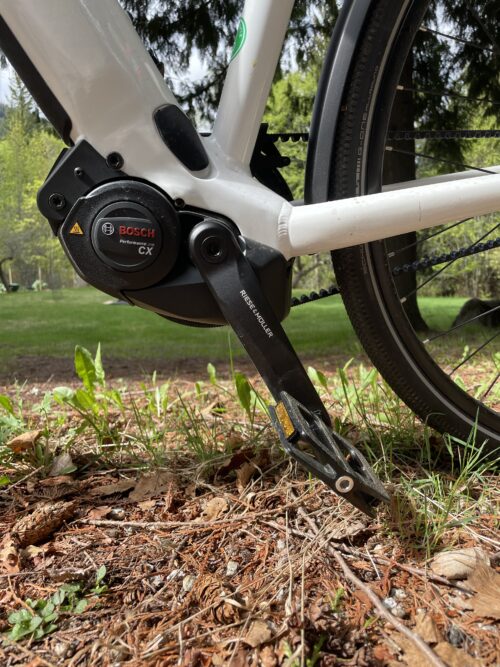I put a lot of thought into my recent e-bike purchase, informed by two years of all-season riding of my previous e-bike. Those two years also made it clear that I was not just purchasing a bike, but a car replacement. Because of that, I recalibrated my budget upwards. I ended up buying a German-made urban-style bike with a mid-drive Bosch motor, internal hub gearing, and a carbon belt drive. I test-rode it in Toronto and had it shipped to meet me back home. My 2022 Riese&Müller Roadster arrived a couple of days after my 60th birthday. Being last year’s model and bike shops generally having too much inventory, I got a great deal on it, but it still cost approximately three times what we paid for the Rad Mini!
I’ve had the new bike for a couple of weeks now, and with 200 km on the odometer under a variety of conditions, here are my impressions so far:

It feels like a piece of modern German engineering: sleek and efficient and powerful. Although its peak power is actually a little lower than the Rad’s, it feels more powerful, and it functions beautifully under load. That’s the magic of a mid-drive motor as opposed to the hub-based motor the Rad had. Just as a person without a lot of strength can pedal up a hill by shifting to a lower gear, a mid-drive motor enjoys the same gearing advantage. The bike doesn’t necessarily go all that fast up hills especially while heavily laden, but the motor happily hums along, rather than moaning at low RPM and ultra-high torque like the Rad used to. So I love the mid-drive motor and I am sure it will last for ages.
The next big difference is in the way the assistive power is calculated and applied. The Rad’s power assist was simple and additive. In Eco mode, you would receive an additional 100 watts of power as soon as the pedals started turning. One notch up would give you 200 extra watts, and so on. There wasn’t much finesse to it and there would be a bit of a lurch as the assist kicked in or notched up: kind of an on/off-switch effect.
With the R&M Bosch system, the power assist is scaled and responsive. The harder you pedal, the more the bike assists you, thanks to a torque sensor and some math. I would estimate that the scale probably results in about 1.5 times your pedaling power in Eco mode, 2 times in Tour mode, 2.5 in Sport and 3 in Turbo. There’s some nuance to it thanks to additional sensors: when the wheel is turning very slowly at start-up, you get a couple of seconds of greater assist, and when you change your gearing to increase your pedaling cadence, there’s also a wee bit of extra juice provided.
The upshot of the responsive assist isn’t just a more natural feel and less lurching, though it certainly does give that. It also seems to have a really useful psychological effect, at least for me. On the Roadster, pedaling harder is an easy and intuitive way to ask the motor for more help. I don’t have to change assist level settings if I hit a hill: I just pedal harder, and the bike magically provides more help. And so this is what happens when I am mindlessly riding along: I work a lot harder than I used to on the Rad. Not that I have to work harder; it’s just that I tend to naturally and intuitively choose to do so.

The other really noticeable difference is in the geometry of the bike. The Roadster is, as its name implies, designed for roads rather for trails and it’s an upright bike intended to let you see and be seen on the road. The wheels are 650B, so pretty large diameter, and the tires are inflated to higher pressure and lacking the knobby tread you’d need to handle loose dirt and mud. With the weight of the motor low down in the centre of the bike, its handling is much more stable at high speeds. As I typically hit 60-65 km/h coasting down the hill that connects my home to the village, I love that I no longer have to apply the brakes to quell the dangerous front-wheel shimmying I used to experience on the Rad. Additionally, the much lower rolling resistance and lighter weight of the Roadster mean that it coasts beautifully, and on flatter terrain I don’t usually use any assist at all. It feels like a marvelous and efficient normal bicycle.
A few other features I love:
- front and rear lights are both bright, and integrated with the battery and the controls
- proper mudguards: I no longer end up with road spray and grit between my teeth!
- the Snapit connectors for the Racktime rack that allows me to swap out different cargo configurations
- the Abus frame lock and chain, since I finally have a bike that I feel I should be locking up even here in our wee village
- the incredibly quiet belt drive
- the “little guy” on the grip-shift gear controller: instead of a numerical gear system, there’s a pictogram of a little guy riding up a hill and the steepness of the hill changes mechanically as you shift

Overall the Rad felt like a motor with wheels, but the Riese & Müller Roadster feels like a bicycle, with superpowers. Since I love bicycles a lot more than I love motors, I’m in heaven.
The hydraulic brakes, the belt drive and the internal hub gearing are the features that will really come into their own next winter, so in-depth thoughts on those will have to wait.

